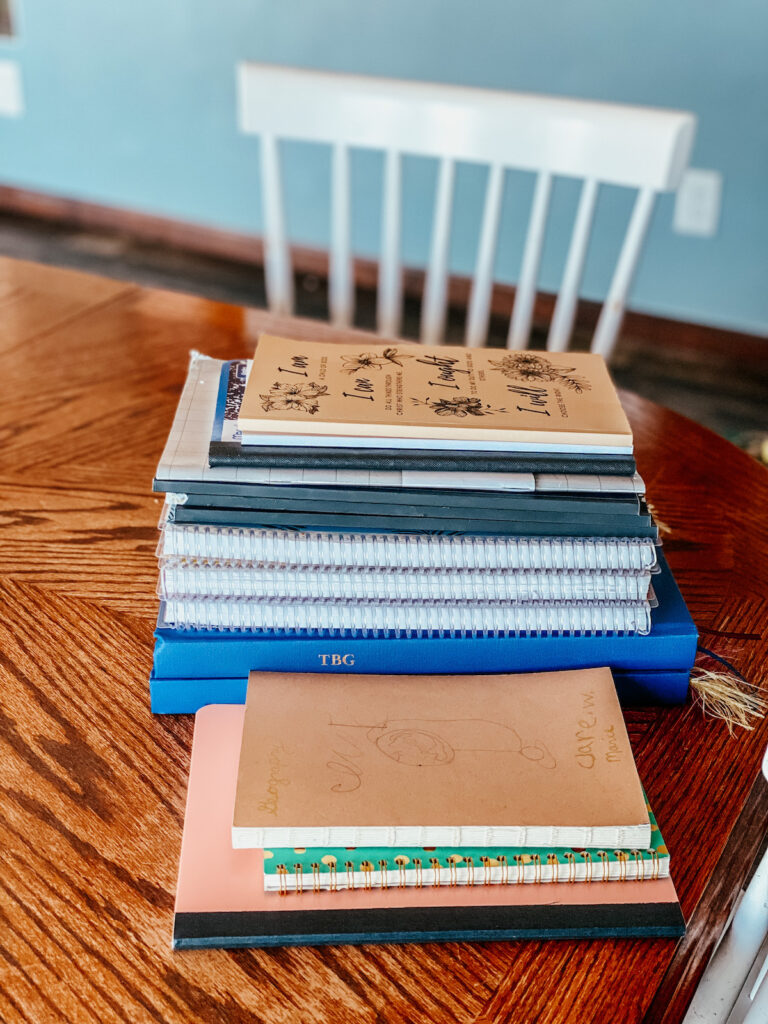Disclosure: Joyfully Domestic may earn a commission for purchases made after clicking links on this page. View our disclosure policy for details.
Today I’m sharing how I make time for Mother Scholé in my daily routine and a list of some of my favorite books & things for keeping up on this experience in the home.

What is Mother Scholé?
If you’ve been around the Classical Charlotte Mason world for a little while, you may have heard the term Mother Scholé.
Mother Scholé in the Charlotte Mason philosophy is the idea that mothers should take care of themselves by cultivating their minds and creating a culture in their homes. The philosophy is based on the idea that mothers are people too, and that they should continue to learn and grow.
This term is not something specifically from Charlotte Mason herself. However, she did write about mother’s education and culture.
I first read about this term mother-culture in her book with the same title by Karen Andreola. And it is such a good phrase for summarizing what we should do as mother’s and home educators, isn’t it?
But upon further study in the CM world, I learned it is mentioned in the Parents’ Review. Here is an article from the Parents’ Review about Mother Scholé.
Importance of Mother Scholé
Being a mother-teacher is challenging work. Add in the various duties of our vocation as a wife and motherhood in general… we have many hats to wear. And if we are not taking the time for ourselves, we can easily get burned out.
This is not something that is selfish either. I mean, even the priests and religious have time for recreation in their daily schedule.
I’m not talking about regular outings outside of the home or lengthy leisure time because many of us don’t have that luxury.
But adding in little pockets of time throughout the day or 30 minutes in the afternoon after school for some reading, study, and culture is so beneficial.
Mother must have time to herself. And we must not say “I cannot.” Can any of us say till we have tried, not for one week, but for one whole year, day after day, that we “cannot” get one half-hour out of the twenty-four for “Mother Culture?”–one half-hour in which we can read, think, or “remember.”
Parents’ review “mother culture” by “A.”
Volume 3, no. 2, 1892/93, pgs. 92-95

A Practicum for Mother Teachers
In the Charlotte Mason and Classical philosophy of education, Mother Culture refers to the ongoing education, enrichment, and self-care of mothers (or primary educators) to nurture their personal growth, intellectual curiosity, and well-being.
This term is from the Parents’ Review article that I linked above, but has since become trademarked. So I refer to this mother’s education or academia as Mother Scholé.
Charlotte Mason emphasized that mothers and educators should cultivate their own minds and interests to stay vibrant, motivated, and well-equipped to guide children in their education.
The idea behind Mother Scholé is that educators also need nourishment for their hearts and minds, just as children do.
Mason believed that teachers and parents should read living books, pursue hobbies, study various subjects, engage in meaningful conversations, and even take quiet moments to reflect and recharge.
This practice allows mothers to model a love of learning and brings fresh enthusiasm and wisdom to the home atmosphere, which directly benefits children.
How I Make Time for Mother Scholé
In our home, I try to (loosely) follow a daily schedule as part of my mother’s rule of life. I know that this may not work for all of us, but this is what I find is important in my home.
My children need a regular schedule and structure, and I have a child with special needs that routines are especially necessary.
So within this schedule, I have time set aside for leisure reading or times where I can work on projects that aid in my mother’s academia.
Sometimes, things happen and the schedule doesn’t go exactly according to plan. And instead of getting distraught over the situation, I learn to become flexible.
So…maybe I’ll listen to a few minutes of an audio book instead of reading that day. Or I go for a nature walk with the children and enjoy the time outside instead of sitting down with my embroidery.
Or I may not have time to draw on my own and will watercolor when the children watercolor during the week.

Routine for Mother Scholé
Like you, I know how fast the days fly by when we are so busy with our daily duties. But if only we can carve out 30 minutes of reading for ourselves.
Sometimes circumstances are difficult and finding the time is hard. But if we truly want to regain the lost art of mother culture, we just need to make the time.
And if you’re still in a habit of scrolling on social media, simply replace that time with reading a good book. I quit social media quite awhile ago, and it was one of the best decisions I’ve made in a long time!
My schedule & routine is kept fairly simple. I wake up early (anywhere between 4:00-5:00 am depending on the season). First thing, I say my morning prayers, have time for meditation/contemplation, and reflection. And then I have some time for spiritual reading alone.
Then I have a morning routine with the kids. After prayers, breakfast, and our homestead chores, we begin school.
During school time, I like to take on the posture of a student and I’m learning alongside the children. We read aloud from this classic book list (at the end in the appendix), there’s room for independent reading, and other work too.
In the afternoons, we work on our daily chores & other duties, have free time, etc. This is where I find little pockets to read from one of the classic works or other books on my list.
On Friday’s, I like to focus on the arts in our home. I like to call it “Fine Arts Fridays”. There’s poetry reading, novels, solfège lessons, composer, and artist study — and we do nature study & watercolor together.

The wisest woman I ever knew–the best wife, the best mother, the best mistress, the best friend–told me once, when I asked her how, with her weak health and many calls upon her time, she managed to read so much, “I always keep three books going–a stiff book, a moderately easy book, and a novel, and I always take up the one I feel fit for!” That is the secret; always have something “going” to grow by. If we mothers were all “growing” there would be less going astray among our boys, less separation in mind from our girls.
Parents’ review “mother culture” by “A.”
Volume 3, no. 2, 1892/93, pgs. 92-95

Ideas for Mother Scholé
The quote above mentions keeping several books going — a stiff book, a moderately easy book, and a novel. This is a practice that I highly recommend and something I’ve personally found much success with.
I would like to add in the addition of spiritual reading to the list. I make specific spiritual reading time in my morning, after my morning prayers, meditation, and before the children wake for the day.
Then I find pockets to read other books like mother’s educational books, novels, etc.
As a part of our homeschool this year, we are reading many books from John Senior’s 1,000 Good Book list.
Like many of you, I did not grow up with a classical education. So, many of the ideas and books on John Senior’s list were new to me. Over the years, I’ve been able to check off a few here and there. And now I read many aloud to my children too.
Methods of Mother’s Education
In both the Charlotte Mason and Classical traditions, the mother’s continuous self-education is seen as enriching her life and the family’s, creating a learning environment filled with curiosity and joy.
Here are a few ideas for mother culture at home:
- Reading for Growth and Pleasure – Engaging with literature and subjects that inspire and educate.
- Creative Pursuits – Hobbies like art, music, gardening, or writing to cultivate creativity.
- Self-Care – Recognizing the importance of rest, reflection, and physical care.
- Community Connection – Seeking encouragement and ideas from other like-minded educators or parents.
Keeping a variety of mother’s notebooks is also something that I enjoy as part of my mother culture.
Booklist for Mother Teachers
If you’re completely new to the idea of mother-culture, I would suggest starting with reading this Parents’ Review Article.
Next, find books that interest you, starting with the categories as mentioned and kept in rotation — a stiff book, a moderately easy book, and a novel. I’d also add in a spiritual reading book too.
If you’re pressed for time on some days (which can’t be helped sometimes), add in an audio book too. But its also important to make sure that this isn’t a regular habit — you should be able to find the time to recharge most days.
A great place to start with finding a list of books to read is to take a look at John Senior’s 1000 Good Book list. I’m regularly adding items from this list to our bookshelves.
And I find myself pulling from this list to read leisurely or aloud to the children. Which is a fun way to sneak in some extra mother culture time.
Below is a snapshot of a few of my current reads and some books that I’ve recently read. I’ve included a few of these favorite book reads here.
At TAN Books:
Discount Code
If you’re ordering from TAN Books, use code: JoyfullyDomestic15 for 15% OFF!

♡ What are your favorite ways of bring mother scholé into the home? Share with us in the comment section below!





